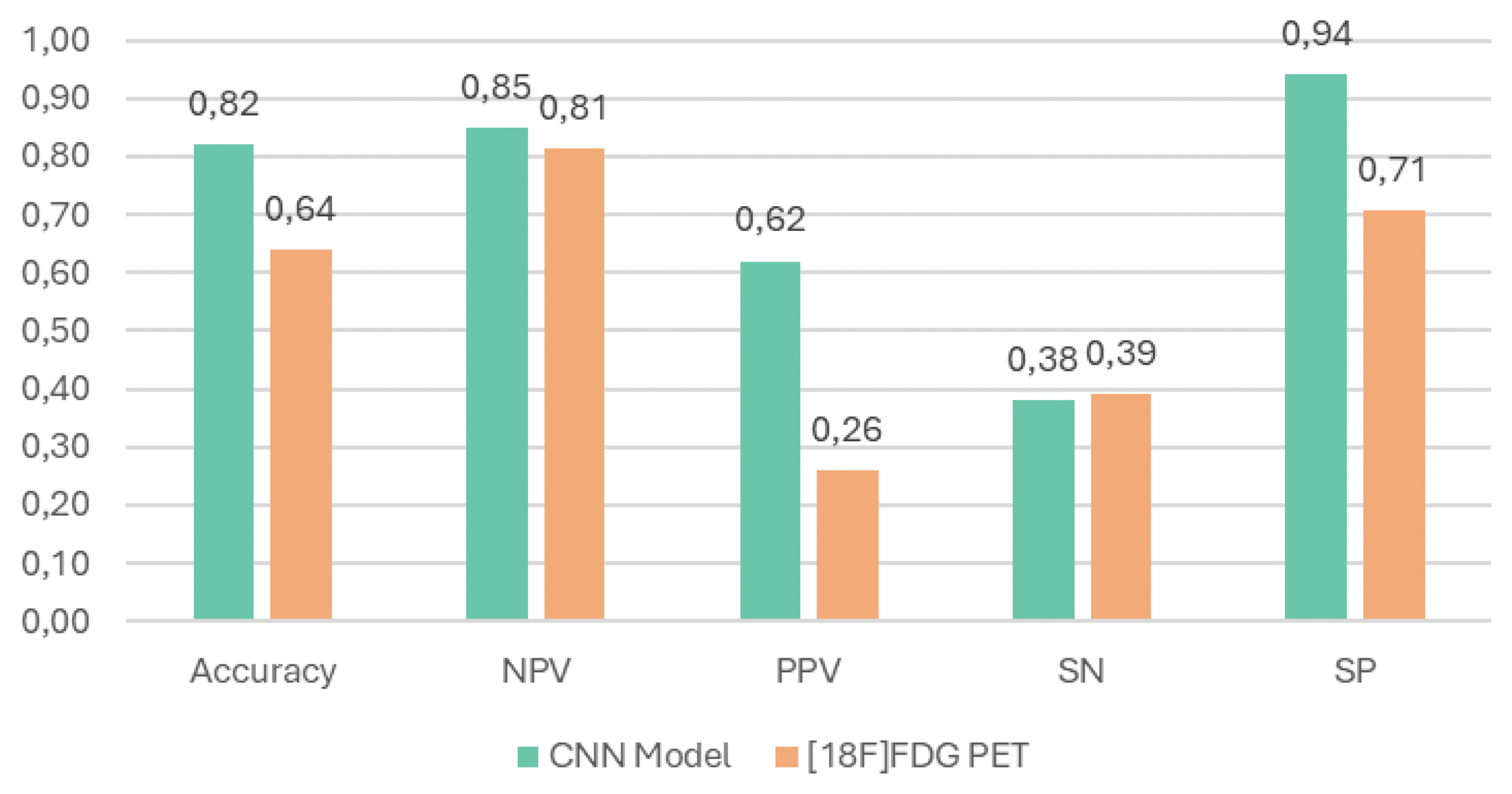

Background: Takayasu arteritis (TAK) is a large vessel vasculitis characterized by fluctuating activity and a lack of specific biomarkers. Hence, disease monitoring and individualized therapy planning are among the main challenges in its management. Although [18F]FDG PET imaging can provide high sensitivity for TAK diagnosis, its reliance on visual analysis is hampered by biases and variability. Additionally, its role in assessing disease progression remains debated and there are no data on its ability to predict relapses. While semi-quantitative metrics, such as standardized uptake value (SUV), are limited by TAK’s structural complexity, convolutional neural networks (CNNs), enable automated feature extraction, overcoming the challenges of TAK segmentation.
Objectives: To investigate whether [18F]FDG PET-based CNN models can predict TAK clinical relapse within 12 months of a baseline [18F]FDG PET scan, thereby supporting the management and therapy planning of patients with TAK.
Methods: [18F]FDG PET scans acquired between 2013 and 2023 from TAK patients at our institution were retrospectively analyzed. Scans were resized, cropped, and harmonized. Several CNN architectures were trained to predict relapse within 12 months: Baseline Model (4 convolutional layers), Residual Bottleneck Model (3 residual bottleneck blocks), ResNet18, and DenseNet121 (both retrieved from the MONAI library). Relapse was defined by recurrence of TAK-related signs or symptoms as determined by a physician who retrospectively reviewed the medical charts blinded to [18F]FDG PET scans. The dataset was split into training, validation, and test sets. To investigate model performance on a balanced dataset, subsampled test sets were created by randomly subsampling the majority class 10 times. Class weighting was employed to account for class unbalance; early stopping and data augmentation were applied to limit overfitting. Model performance was evaluated using accuracy, precision, recall, specificity, and normalized Matthew’s correlation coefficient (nMCC).
Results: A total of 306 [18F]FDG PET scans from 74 patients with TAK (12 males, 62 females; median age 47 years, range 14–75) were analyzed. Sixty-four scans (21%) were followed by relapse within 12 months. Of these, 39 and 25 were classified as negative and positive, respectively, by a nuclear medicine physician blinded to follow-up data. The optimized liver-based standardization method allowed to remove all differences in mean voxels comparison across tomographs and was used to harmonize the scans before being ingested into the models. Among the CNN models, best results on both the test set and the subsampled test set were overall provided by Baseline Model-1 (monitored metric: accuracy; data augmentation: RandAffine) and DenseNet121-2 (monitored metric: accuracy; data augmentation: RandAxisFlip). Precisely, on the test set, Baseline Model-1 achieved 82% accuracy, 85% precision of class 0, 62% precision of class 1, 38% recall, 94% specificity and 70% nMCC, while DenseNet121-2 provided its potential in identifying complete TAK remission, with 81% accuracy, 80% precision of class 0, 100% precision of class 1, 8% recall, 100% specificity and 62% nMCC, maintaining 100% precision of class 0 and specificity in the subsampled, balanced test set. Baseline model-1 ability in predicting TAK relapse is visually compared to standard [18F]FDG PET assessment in Figure 1.
Conclusion: This study represents the first application of CNN-based PET analysis in TAK, involving one of the largest cohorts reported in the literature. Despite limitations, including a retrospective design and imbalanced dataset favoring remission detection, the study demonstrates the potential of CNN models to analyze [18F]FDG PET scans and predict TAK remission. These findings suggest improved accuracy in identifying patients who can safely reduce therapy, thereby avoiding unnecessary treatments and intensive follow-up.
Comparison between [18F]FDG PET and CNN model (Baseline model-1) in prediction of clinical relapses at 12 months of patients with Takayasu. NPV: negative predictive value; PPV: positive predictive value; SN: sensitivity; SP: specificity.

REFERENCES: NIL.
Acknowledgements: NIL.
Disclosure of Interests: Alessandro Tomelleri Fresenius-Kabi, Novartis, Novartis, Carolina Bezzi: None declared, Sara Resta: None declared, Corrado Campochiaro: None declared, Federico Fallanca: None declared, Elena Baldissera Novartis, Roche, Samuele Ghezzo: None declared, Nicola Farina Johnson & Johnson, Arturo Chiti: None declared, Paola Mapelli: None declared, Marco Matucci-Cerinic: None declared, Maria Picchio: None declared, Lorenzo Dagna Johnson & Johnson, Eli Lilly, Novartis, UCB, Abbvie.
© The Authors 2025. This abstract is an open access article published in Annals of Rheumatic Diseases under the CC BY-NC-ND license (